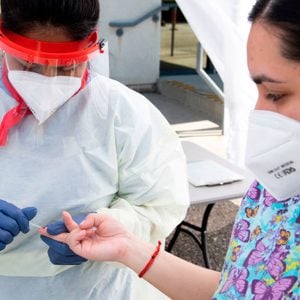What Patient Zero in the U.S. Can Tell Us About Coronavirus
Updated: Aug. 27, 2020
Health experts explain the importance of identifying patient zero in a pandemic to learn more about the disease, Covid-19, and contain it.
On Wednesday, January 15, a 35-year-old man arrived at Seattle-Tacoma Airport after traveling for about 20 hours from Wuhan, China, where he had been visiting family. He had a mild cough and may have been running a fever, according to a report in the New England Journal of Medicine. Upon arrival, he took shared transport from the airport to his home, according to Bloomberg BusinessWeek. The Centers for Disease Control and Prevention (CDC) had not yet started screening passengers for the novel coronavirus already circulating in China.
Soon after getting home, the patient saw an alert from the CDC asking Americans who felt sick and who had been in China to find medical care. The patient went immediately to an urgent care clinic in Snohomish County, north of Seattle. He wore a mask and waited 20 minutes until he was ushered into an examination room. After learning about his travel history and after tests for other infections came back negative, medical staff sent the patient’s samples overnight to the CDC headquarters in Atlanta to be tested for Covid-19. He was told to go home and isolate himself.
The next day, the results came back. He was positive.
The concept of “patient zero”
Every epidemic or pandemic has a “patient zero,” also known as the index patient or index case. This is the first human to be infected in an outbreak. Technically, patient zero for Covid-19 would be the first human who contracted the virus in China—who, according to Chinese government data, may have been a 55-year-old Hubei man who contracted the virus as early as November 17, 2019. That man presumably got the virus from an animal at a Wuhan seafood market.
For the United States, media reports have been referring to the 35-year-old man in Seattle as patient zero. As it turns out, he likely was not the first infected person in the country, although he appears to be the first confirmed case. In an email, a spokesperson for the King County (Seattle) Department of Public Health said that the department has been unable to investigate patient zero because all their resources are tied up in mitigating the spread already happening. (Is there going to be a second coronavirus wave?)

The importance of patient zero
Finding the first person infected can be key to learning how a virus (or another organism) has spread and, therefore, the key to controlling it. “It helps us determine the time and day that [the infection happened] then project the trajectory of it,” explains Ravina Kullar, PharmD, a spokesperson for the Infectious Diseases Society of America (IDSA).
Patient zero is basically the source from which all information about the outbreak flows, adds Greg Poland, MD, professor of medicine and infectious diseases at the Mayo Clinic in Rochester, Minnesota and also an IDSA expert. Officials can then trace his or her contacts and possibly prevent more transmission. This includes “Where did you go? Who did you have contact with? Eat with? Which airplane?” says Dr. Poland. “We begin to understand who it is infecting, how many, the symptoms they are having. With these questions, you begin to spread out the knowledge base.” (Read about a day-in-the-life of a Covid-19 contact tracer.)
You may be interested in learning about the H1N1 Swine Flu Pandemic of 2009-2010.
What happened to Seattle’s patient zero
After the Seattle man tested positive, he was admitted to a special isolation unit at Providence Regional Medical Center. Meanwhile, health officials tracked down 70 people he had been in contact with and took nasal swabs from 50. Not one tested positive. Yet the virus continued to spread, suggesting there was a different patient zero, someone still unknown.
On February 28, the Snohomish Health District announced that a local high school student had tested positive for coronavirus. This appears to have been the first community transmission of the virus. Officials set out to track that patient’s contacts but the virus had already moved on, notably to a nursing home in Kirkland, Washington, where several residents ultimately died. As of March 28, the latest stats available, Washington State reported 4,896 cases of Covid-19 and 195 deaths.
The difficulty of finding patient zero
The difficulty of finding patient zero varies from outbreak to outbreak. Experts know the exact identity and movements of the patient who brought SARS (severe acute respiratory syndrome) to Hong Kong in 2003. He was a 64-year-old doctor from mainland China who went to Hong Kong for a wedding. He checked into room 911 on the ninth floor of the Metropole Hotel, where he infected seven other people staying on the same floor. SARS was contained relatively quickly.
Finding patient zero in the Covid-19 pandemic has been complicated by the symptom profile, according to the World Economic Forum (WEF). Unlike SARS, says Dr. Poland, Covid-19 can spread even when there are no symptoms, making it harder to identify and trace patient zero and his or her contacts.
“That patient zero may have been asymptomatic and not gone into the hospital,” says Dr. Kullar, who is also adjunct faculty at UCLA’s David Geffen School of Medicine. “That’s what prevented us from even getting to patient 1 or 2.”
“It is only those people who are both sick enough and who have access to healthcare that can help us know what’s going on,” adds Dr. Poland. “With asymptomatic disease, you never knew there was a patient zero and you don’t know until somebody gets sick and/or gets tested. This is sometimes like chasing wisps of fog.”
Is it ever too late to find patient zero?
Ideally, patient zero is located at the start of an outbreak, as in the case of SARS. With Covid-19, the WEF points out, people are transmitting the virus without having noticeable symptoms, making it incredibly difficult to trace contacts.
“Identifying patient zero becomes extremely important at the beginning of any kind of epidemic or pandemic,” says Dr. Poland. “It’s now too late for that. Identification is no longer the issue. It’s now containment and suppression.”
Covid-19 is moving fast and no one in the world has more than 12 weeks experience with this specific strain of coronavirus, Dr. Poland points out.
The problem stems from the fact that it can take two or more weeks for symptoms to appear. “This lag period is very difficult for people to understand,” says Dr. Poland. It’s one reason people aren’t social distancing as they should.
Where we are now
Dr. Poland compares understanding a pandemic to a photo slowly loading on your computer screen. “You start with a blank canvas,” he says. “In early January we had five pixels. It looked like dust on an empty canvas.”
Once you have 50 to 60 percent of the pixels, he says, you know it’s going to be a picture. At 80 to 90 percent you see what the picture is. “We’re back in the 20 to 30 percent pixelation at best,” he says.
Much of the confusion surrounding the current pandemic is likely due to the inability to identify China’s patient zero and subsequent patient zeros, says Dr. Kullar. “It’s been a couple of months, we still don’t have answers to really critical questions,” she adds. “There’s a lot of speculation but no definitive answers.”
The 35-year-old man in Seattle who was the first confirmed case of Covid-19 in the United States has since recovered. As of March 31, the United States had the most confirmed cases worldwide.



